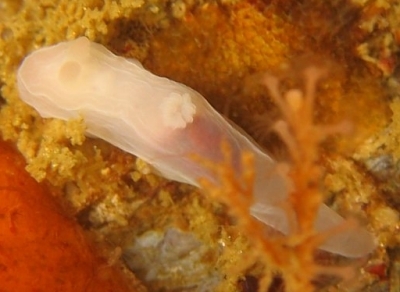
Lecithophorus capensis
Macnae, 1958
Order: NUDIBRANCHIA
Suborder: DORIDINA
Superfamily: ANADORIDOIDEA
Family: Gymnodorididae
DISTRIBUTION
It appears to be endemic to the Cape Province, South Africa. Uncommon intertidally it is one of the most common nudibranchs seen around the Cape Peninsula, in depths from 2m to 30m and deeper.
PHOTO
Locality: Cape Peninsula, 2 to 30 m, South Africa, Atlantic, Vertical reef walls. Length: 20mm. Photographer: Guido Zsilavecz.
Animal is a translucent whitish colour with the browns and yellows of the internal organs showing through the semitransparent body wall. It is elongate, with the mantle skirt reduced to a narrow ridge. The simple pinnate gills are relatively small, forming a ring around the anus in the posterior midline. They do not retract into a gill pocket but can contract to quite small lumps when the animal is disturbed.
Lecithophorus capensis grows to about 20 mm in length, but are often smaller. Gosliner notes that this species is uncommon intertidally but one of the most common subtidal nudibranchs on both sides of the Cape Peninsula. It appears to be endemic to the Cape Province, South Africa. It is reported to feed on erect bryozoans.
-
Macnae, W. (1958) The families Polyceridae and Goniodorididae (Mollusca, Nudibranchiata) in southern Africa. Transactions Royal Society South Africa 35(4), 341-372. (Pls.17-18)
-
Gosliner, T. M. (1987) Nudibranchs of Southern Africa, a guide to the Opisthobranchs of southern Africa. Monterey, Sea Challengers. 1-136.
Rudman, W.B., 2007 (May 18) Lecithophorus capensis Macnae, 1958. [In] Sea Slug Forum. Australian Museum, Sydney. Available from http://www.seaslugforum.net/find/lecicape
Related messages
Lecithophorus capensis from South Africa
May 21, 2007
From: Guido Zsilavecz
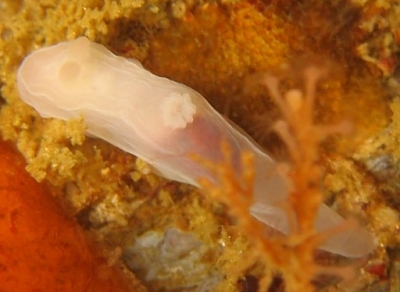
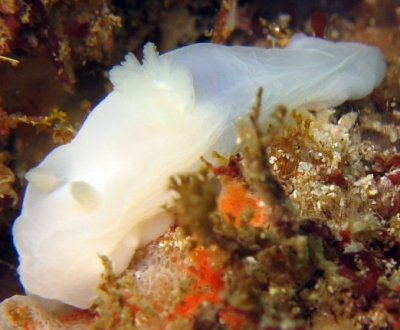
Concerning message #16412:
Good day Bill!
Attached are a few photos of Lecithophorus capensis. Lengths up to 20 mm, often smaller. Seen around the Cape Peninsula, in depths from 2m down to 30m and deeper. They are quite common, and are generally found on well-grown over vertical reefs.
Locality: Cape Peninsula, 2 to 30m, South Africa, Atlantic, Vertical reef walls. Length: 20mm. Photographer: Guido Zsilavecz.
Regards,
Guido
guido@surg.co.za
Zsilavecz, G., 2007 (May 21) Lecithophorus capensis from South Africa. [Message in] Sea Slug Forum. Australian Museum, Sydney. Available from http://www.seaslugforum.net/find/16472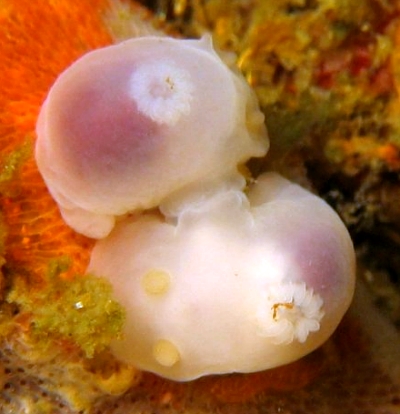
Thanks Guido,
It's taken me a while to get the Fact Sheet organised, but these photos are very welcome. Apart from being a new addition to the Forum they show a couple of interesting things. Firstly, in the photo of the mating pair, the gills look quite different in shape to the branching gills of the animal in the middle photo, but the difference is because the gills in the lower photo are contracted. Lecithophorus belongs to the half of the dorid nudibranchs which do not have a pocket into which their gills can be retracted when the animals are disturbed. All they can do to protect them is to make them as small as possible until the danger passes.
The other point of interest is that Macnae, when he described this species, suggested that they probably ate colonial ascidians, but Terry Gosliner reports them feeding on erect bryozoans. In the mating photo the animals are on an orange encrusting bryozoan. In the background, part of the colony is just the white skeleton suggesting the orange animal has been eaten. In the middle photo it also seems the animal is on a bryozoan colony with orange and white patches, suggesting exactly the same situation.
Best wishes,
Bill Rudman
Re: Dorid from South Africa
April 25, 2006
From: Guido Zsilavecz
Concerning message #2678:
Good day:
This species looks very much like Lecithophorus capensis - it is white, but slightly see-through behind the gills. We call it the "ghost nudibranch" for that reason. In Cape Town it is common on most reefs.
Regards,
Guido Zsilavecz
guido@surg.co.za
Zsilavecz, G., 2006 (Apr 25) Re: Dorid from South Africa. [Message in] Sea Slug Forum. Australian Museum, Sydney. Available from http://www.seaslugforum.net/find/16412Dear Guido,
Thanks very much for getting back to us on a longterm 'unknown'. I would be very grateful for some photos of Lecithophorus capensis, if you have any, as it is not found outside South Africa, and the only photo I have seen of it is the one in Terry Gosliner's Nudibranchs of South Africa.
Best wishes,
Bill Rudman
Dorid from South Africa
May 2, 2001
From: Valda Fraser
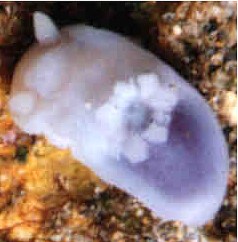
Dear Bill
I am clueless as regards this nudibranch. It was perched on a whitish whip coral looking frond.
Locality: Hlukela, Transkei, SOUTH AFRICA - 18m
Date: June 2000
Size: 12mm
Regards
Valda
iti04937@mweb.co.za
Fraser, V., 2001 (May 2) Dorid from South Africa. [Message in] Sea Slug Forum. Australian Museum, Sydney. Available from http://www.seaslugforum.net/find/2678Note added 21 May 2007: This is Lecithophorus capensis.
Dear Valda,
A dorid on a whip coral, by which I presume you mean a gorgonian, is not something that rings a bell. I don't know of a dorid that associates with, or eats, gorgonians. It is possible it was just passing by, but I'm afraid its shape doesn't give me many clues.
Hopefully someone will have an idea. I don't like consigning species to the 'unidentified' page.
best wishes,
Bill Rudman
